Shipping Study of the Pentland Firth and Orkney Waters
A study of shipping activity to better inform the marine spatial plan pilot for the Pentland Firth and Orkney Waters Strategic Area. The aim of this process is to ensure there is good knowledge of the
use of these waters by all stakeholders so that futur
7. COMMERCIAL SHIPPING ANALYSIS (ais)
7.1 Introduction
This section provides background information on AIS and presents analysis of the winter and summer AIS commercial shipping survey carried out of the Pentland Firth and Orkney Waters Strategic Area.
Recreational vessel tracks have been excluded from this section as these are analysed separately in Section 8.
Other vessel types excluded are commercial fishing vessels and military vessels (as explained in Section 2, these are addressed in separate studies by Marine Scotland) and port vessels e.g., pilot vessels (as these operate to support other vessel activities).
7.2 Background Information on AIS
7.2.1 Carriage Requirements
Regulation 19 of SOLAS Chapter V - "Carriage requirements for shipborne navigational systems and equipment" - sets out navigational equipment to be carried on board ships, according to vessel type. In 2000, the IMO adopted a new requirement (as part of a revised new chapter V) for ships to carry Automatic Identification Systems ( AIS). AIS is a system by which ships send data concerning their position, MMSI etc on two individual VHF channels to the shore and other vessels, at very frequent intervals. The data are transmitted automatically via VHF to other vessels and coastal stations/authorities.
The regulation requires AIS to be fitted aboard all ships of 300 gross tonnage and upwards engaged on international voyages, cargo ships of 500 gross tonnage and upwards not engaged on international voyages, and passenger ships irrespective of size built on or after 1 July 2002. It also applies to ships engaged on international voyages constructed before 1 July 2002, according to the following timetable:
- passenger ships, not later than 1 July 2003;
- tankers, not later than the first survey for safety equipment on or after 1 July 2003;
- ships, other than passenger ships and tankers, of 50,000 gross tonnage and upwards, not later than 1 July 2004.
An amendment adopted by the Diplomatic Conference on Maritime Security in December 2002 states that ships, other than passenger ships and tankers, of 300 gross tonnage and upwards but less than 50,000 gross tonnage, will be required to fit AIS not later than the first safety equipment survey after 1 July 2004 or by 31 December 2004, whichever occurs earlier. Ships fitted with AIS shall maintain AIS in operation at all times except where international agreements, rules or standards provide for the protection of navigational information.
The regulation requires that AIS shall:
- provide information - including the ship's identity, type, position, course, speed, navigational status and other safety-related information - automatically to appropriately equipped shore stations, other ships and aircraft;
- receive automatically such information from similarly fitted ships; monitor and track ships;
- exchange data with shore-based facilities.
7.2.2 Data Broadcast
There are two classes of AIS system, "A" and "B", which both broadcast slightly different data. The information transmitted by ships using Class A and B is given below:
- fixed or static information, which is entered into the AIS on installation and need only be changed if the ship changes its name or undergoes a major conversion from one vessel type to another;
- dynamic information, which, apart from 'Navigational status' information, is automatically updated from the ship sensors connected to AIS; and
- voyage-related information, which might need to be manually entered and updated during the voyage (this is only broadcast on Class A).
The Class A AIS system is mandatory under Regulation 19 of SOLAS Chapter V. Class A messages are broadcasted every 2 to 10 seconds, depending on the vessel's speed and rate of turn. When a ship is static or at anchor there is an update rate of once every 3 to 6 minutes.
The following lists present the data provided via Class A AIS.
Table 7.1 Class A AIS information
| Static | Dynamic | Voyage related |
|---|---|---|
| MMSI | Position (Lat/Long) | Draught |
| IMO Number | Time | Hazardous Cargo (type) |
| Call Sign | Course over ground | Destination |
| Name | Speed over ground | ETA |
| Length and Beam | Heading | Route Plan |
| Type of Vessel | Navigational Status | |
| Type of Nav Sensor | Rate of Turn |
Class B AIS is a less expensive system which may be used voluntarily by smaller, non-SOLAS vessels. The data broadcast are reduced but still contain the main information required for ship tracking and identification. When the vessel is travelling less than 3 knots the update rate is once every 3 minutes, and when static or at anchor there is an update rate of once every 6 minutes. The table below summarises the broadcast Class B information.
Table 7.2 Class B AIS Information
| Static | Dynamic |
|---|---|
| MMSI | Position (Lat/Long) |
| Name | Time |
| Length and Beam | Course over ground |
| Type of Vessel | Speed over ground |
| Heading |
7.2.3 AIS Operational Requirements
Ships fitted with AIS are required to maintain AIS in operation at all times except where international agreements, rules or standards provide for the protection of navigational information.
If the Master believes that the continual operation of AIS might compromise the safety or security of his/her ship, the AIS may be switched off. There are no known factors that should make this necessary in the study area.
AIS is a passive system and will therefore not track vessels that:
- do not carry AIS;
- have turned their AIS transmitter off; or
- have a failed AIS transmitter
Based on the legal carriage requirement, the main vessels that may not carry AIS but are relevant to the study are small vessels, particularly those under 300 gross tonnes, which may include recreational craft. It is noted that although not mandatory, significant numbers of smaller vessels are electing to install AIS as good practice (see Section 8 for more analysis of this).
There is also a possibility that some AIS information could be inaccurate. The dynamic information is automatically fed into the system from the GPS Antenna (positional information) and Gyro (heading). In the event that the Gyro or GPS feed to the AIS unit fails, there will be alarm on the bridge of the vessel to highlight this failure.
Static information, e.g. Vessel Name, tends to be typed in once during the installation and setup of the AIS system on the vessel and after that largely remains untouched. Human error is therefore possible. Voyage related data are normally typed in by the officer of the watch. These fields are more prone to error as they require updating manually prior to each voyage (or more frequently in the case of a change in navigation status, such as anchoring) so can be overlooked or out of date. Studies by Dover Coastguard (Ref. [x]) have indicated these type of errors are still fairly rare (approx. 3%).
The accuracy of AIS has been assessed at Dover Coastguard Channel Navigation Information Service (CNIS) which monitors the Dover Strait. In a 2007 trial it was identified that the AIS data of around 3.5% of ships was in error. Of these errors, the majority were found to relate to voyage related data, e.g., destination and draught. Less than 0.1% of errors were related to dynamic data, i.e., vessel position, course and speed.
Anatec have sought to minimise errors by checking the data and correcting inaccurate information. For example, the Hoy Head ferry was broadcasting a draught on AIS of 12.1m in the winter survey when its design draught is only 2.3m. Overall, the effect of inaccurate information for a small proportion of tracks is considered to be minimal.
7.3 Survey Details
The winter survey data were collected during four weeks in January to early February 2012. The summer survey data were collected over four weeks in July 2012.
Each track plotted represents one vessel movement. A track is created by joining together all the positions broadcast by a ship. A new track is automatically started:
- at midnight each day;
- if there is a time gap of over 30 minutes between position reports; and
- if the dynamic data broadcast by the ship changes, e.g., new draught, destination or navigational status.
It should be noted that the time gap used of 30 minutes means that occasionally a vessel may appear to cross land (based on a straight-line route) when in fact it rounded the land but was not tracked for a few minutes.
The commercial vessel type classification was based on the International Classification of Ship Types (ICST 94), which was considered to be more useful than the type information broadcast on AIS. However, the types were further tailored the project based on discussions with the Steering Group. Seven type categories were defined as follows:
- Tanker (Oil / Chemical / Gas Carrier)
- Bulk/Ore Carrier
- Cargo (including RoRo/Container)
- Passenger (Ferry and Cruise Ship)
- Offshore (Oil & Gas and Renewables Support Vessels)
- Tug
- Other [35]
As noted previously, licensed fishing vessels, fisheries protection vessels, military vessels, harbour tugs, pilot vessels and recreational vessels are not included. It was agreed with Marine Scotland and the Steering Group that these vessels should be excluded as they are not relevant to the project. Recreational vessels are analysed separately in Section 8.
Figure 7.1 summarises the breakdown of vessel movements (tracks) within the Pentland Firth and Orkney Waters Strategic Area by vessel type during both periods.
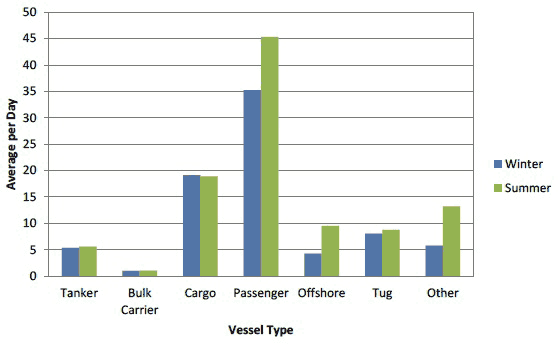
Figure 7.1 AIS Vessel Type Distribution per Season
Overall, the type distribution in summer and winter is fairly similar, with passenger vessels being the most common type followed by cargo vessels.
There was a slightly higher average number of vessels per day during the summer period for the vessel categories of passenger, offshore and other.
Over the combined survey period, 44% of vessels were passenger vessels, with 21% of vessels being cargo ships. Other significant types were 'other' vessels (11%), tugs (excluding harbour tugs) (9%), offshore industry vessels (8%), tankers (6%) and bulk carriers (1%).
Figure 7.2 and Figure 7.3 present the vessel tracks recorded in each period in the Pentland Firth and Orkney Waters Strategic Area, thematically mapped by vessel type. As can be seen from the figures, the commercial vessel tracks follow a number of well-defined routes within the PFOW Strategic Area, but there is also wide use of other less well-defined routes. There was little variation between the summer and winter tracks for the majority of the different vessel types. There were, however, more offshore tracks making additional routes during the summer period, both transiting the Strategic Area and working within the Orkney Islands. Further discussion of the routes taken by the different vessel types is presented in Section 7.4.
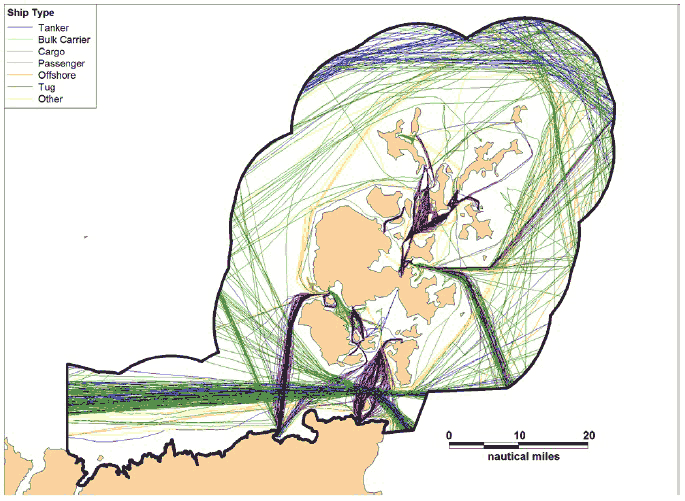
Figure 7.2 Winter 2012 AIS Track Analysis by Vessel Type
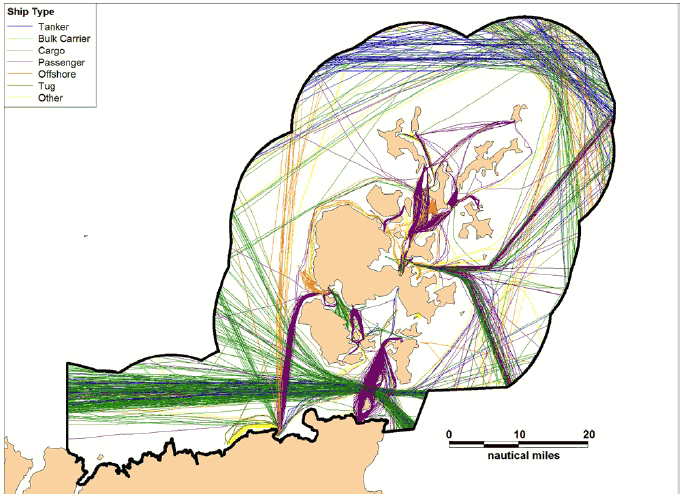
Figure 7.3 Summer 2012 AIS Track Analysis by Vessel Type
7.5 Ship Length Analysis
The length distribution for the winter and summer survey periods is presented in Figure 7.4 (excluding less than 1% of vessels with unspecified lengths which could not be identified from other sources.
Figure 7.5 and Figure 7.6 present seasonal plots of vessels within the Strategic Area, thematically mapped by vessel length.
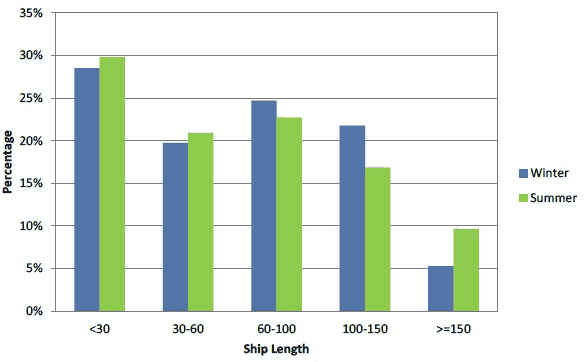
Figure 7.4 AIS 2012 Vessel Length Distribution by Season
The average vessel length in both periods equalled 73m. The most common category was lengths of less than 30m. Regular runners in this category included the Orkney Ferries inter-island passenger ferries and several tugs.
The slightly higher proportion of vessels with lengths greater than or equal to 150m in the summer period (approximately 10% compared with 5% in winter) is due to an increase in the number of large cargo vessels and passenger cruise vessels during this period.
The longest vessel was the tanker, Fida, at 333m, tracked to the north of the Strategic Area and en route to Hound Point marine terminal in the Firth of Forth during the summer period. The longest vessel during the winter survey was the cargo vessel, a fully cellular containership, MSC Eleni, at 294m. This was tracked transiting through the Outer Sound of the Pentland Firth, en route to Bremerhaven.
In terms of vessel tracks, the geographical distribution of vessels by length was similar in both periods. The longest vessels tended to be transiting the area, either passing north of Orkney via the Fair Isle Channel or south of Orkney through the Outer Sound of the Pentland Firth. During summer there were a number of vessels greater than 150m in length which called at Kirkwall. These were all passenger cruise vessels.
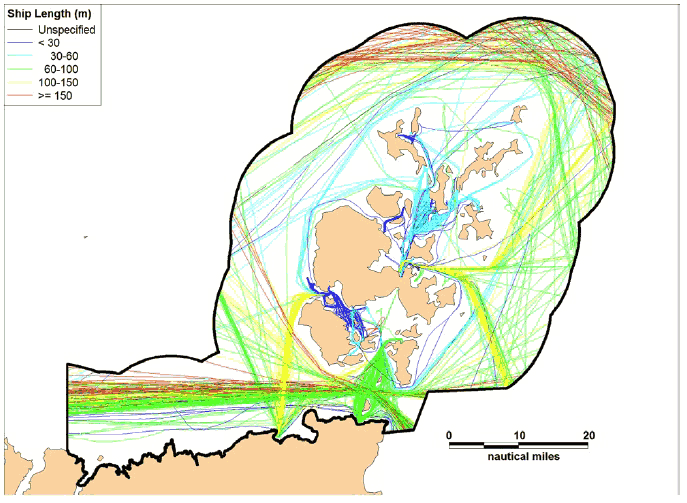
Figure 7.5 Winter 2012 AIS Track Analysis by Ship Length
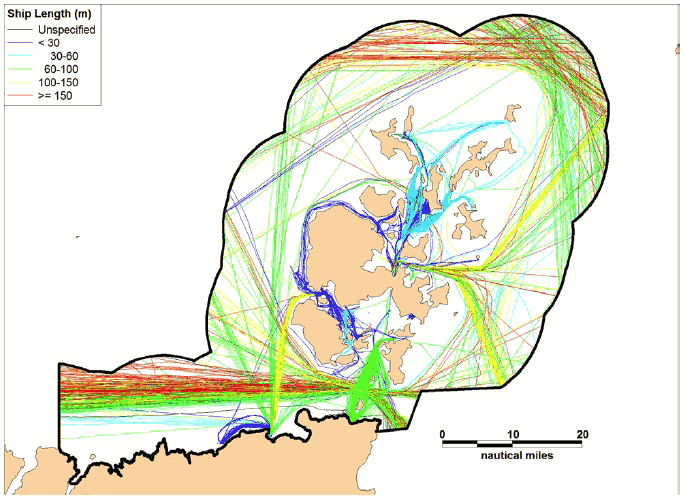
Figure 7.6 Summer 2012 AIS Track Analysis by Ship Length
7.6 Ship Draught Analysis
The draught distribution for the winter and summer survey periods is presented in Figure 7.7 (excluding 23% of vessels in both periods with unspecified draughts). (Note, draught is dynamic data, and varies per voyage, therefore it cannot be precisely researched from literature.)
Figure 7.8 and Figure 7.9 present seasonal plots of vessels within the Strategic Area, thematically mapped by vessel draught.
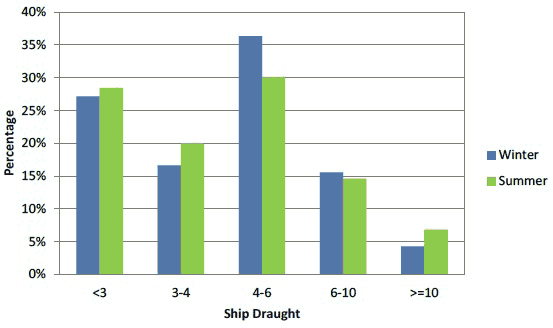
Figure 7.7 AIS 2012 Vessel Draught Distribution by Season
The average vessel draught in both periods was 4.9m. The most common category was 4-6m, comprising 36% of vessels in winter and 30% of vessels in the summer period.
As with length, there was a higher proportion of deep-draught vessels in summer compared to winter. This was mainly due to increased number of large cargo ships. The deepest draught vessel was the floating production tanker, Petrojarl Banff, at 25.5m draught, which was moored in Scapa Flow during the surveys. (Note, this vessel was undergoing repair and normally functions as an offshore oil installation.)
Similar to the longest vessels, the deepest draught vessels tended to be tracked transiting either the Outer Sound of the Pentland Firth or the Fair Isle Channel. Aside from the Petrojarl Banff, only two vessels with draughts greater than 10m were tracked within the Orkney Islands during the surveys. Alfa Britannia, with a draught of 12.4m, was recorded once in summer and once in the winter period, both times en route to Rotterdam. NS Arctic, at 13.6m draught, was recorded once en route to Wilhelmshaven. Both of these vessels were tankers associated with Flotta Marine Terminal, transiting in and out of Scapa Flow.
There were more deep-draught vessels transiting the Pentland Firth and the Fair Isle Channel during the summer period than the winter period.
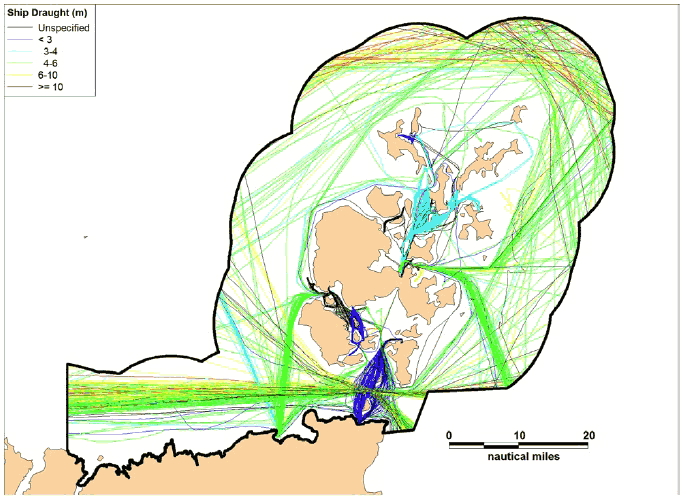
Figure 7.8 Winter 2012 AIS Track Analysis by Ship Draught
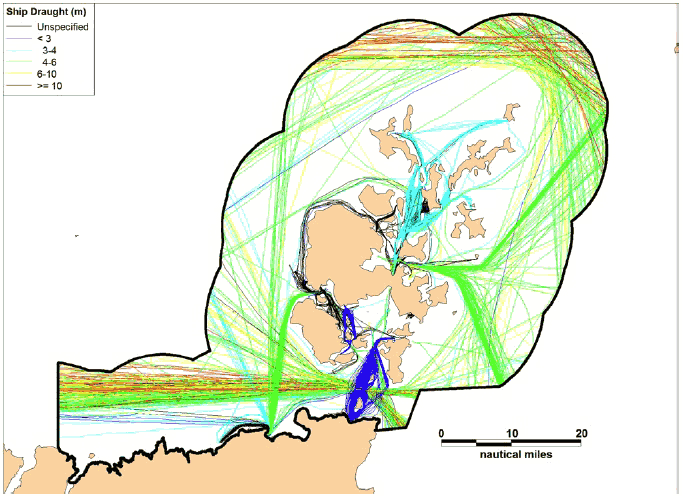
Figure 7.9 Summer 2012 AIS Track Analysis by Ship Draught
7.7 Ship Tonnage Analysis
Figure 7.11 and Figure 7.12 present seasonal plots of the vessel tracks within the PFOW Strategic Area, thematically mapped by gross tonnage (GT). (Note, tonnage information is not broadcast on AIS but was researched separately and appended to the data.)
The ship tonnage distribution recorded over the winter and summer periods is presented in Figure 7.10.
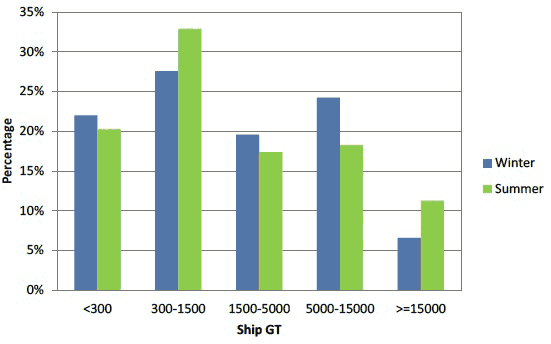
Figure 7.10 AIS 2012 Vessel GT Distribution by Season
The pattern is similar to that observed in the length and draught analysis. The most common category was 300-1,500 GT. Regular runners in this tonnage category included the Pentalina passenger ferry and Orkney Islands inter-island ferries.
Vessels of greater than 15,000 GT represented 11% of ships during summer and 7% in the winter survey. The higher percentage in summer was due mainly to a rise in the number of large cargo vessels and passenger cruise ships in this period.
The average GT of vessels was 5,830 GT in the winter period and 6,550 GT during the summer period.
The heaviest ship in winter was SKS Skeena at 81,380 tonnes. This was a 273m long 15m draught crude oil tanker en route to Portland, Maine and transiting through the Fair Isle Channel. During the summer period, the heaviest ship was Elizabeth I.A., a crude oil tanker with length of 332m and draught of 11.7m. This vessel was also transiting through the Fair Isle Channel, en route to Mongstad.
The heaviest vessels were tracked transiting the Outer Sound of the Pentland Firth and the Fair Isle Channel. During the winter period, the only vessels over 15,000 GT tracked within the Orkney Islands were Alfa Britannia, at 56,100 GT, and NS Arctic, at 62,400 GT. Both of these vessels were tankers associated with Flotta Marine Terminal, transiting in and out of Scapa Flow. Alfa Britannia was also tracked at Flotta Marine Terminal in the summer period. During the summer survey, there were a higher number of vessels over 15,000 GT tracked within the Orkney Islands. These were all passenger cruise vessels, calling at Kirkwall and Stromness.
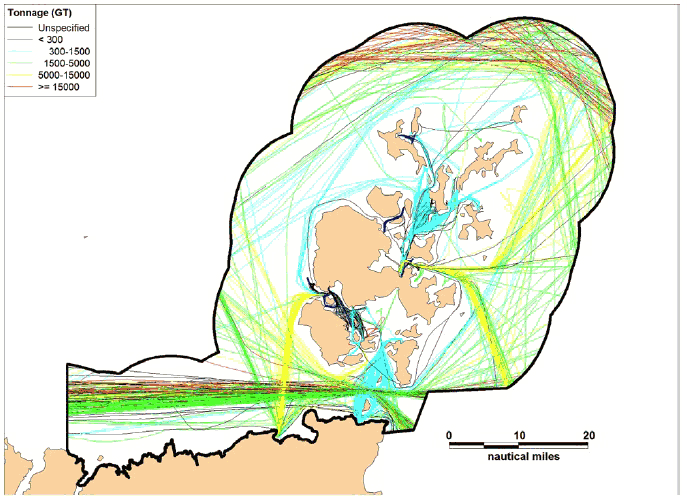
Figure 7.11 Winter 2012 AIS Track Analysis by Gross Tonnage
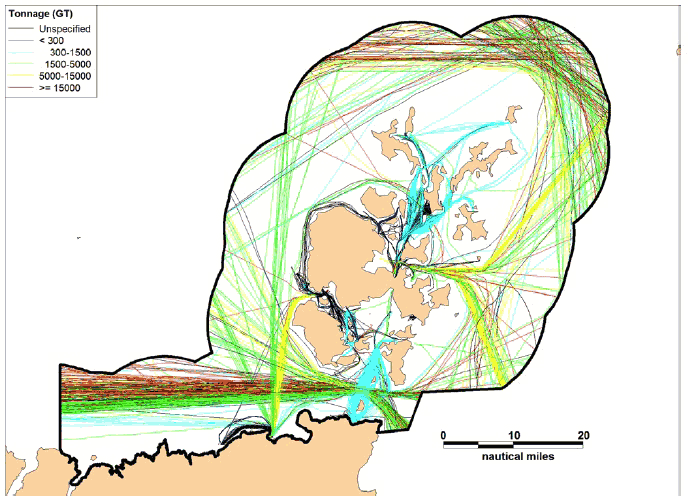
Figure 7.12 Summer 2012 AIS Track Analysis by Gross Tonnage
- Seven vessel type categories were defined (as explained in Section 7.4) as follows:
- Tanker (Oil / Chemical / Gas Carrier)
- Bulk/Ore Carrier
- Cargo (including RoRo/Container)
- Passenger (Ferry and Cruise Ship)
- Offshore (Oil & Gas and Renewables Support Vessels)
- Tug
- Other [36]
These type categories are analysed in further detail in the following sections.
7.8.1 Tankers
Figure 7.13 presents the tankers and gas tankers recorded within the Strategic Area during the combined 56 day survey period. Overall, 145 unique tankers were tracked. Four of these were gas tankers and 141 were tankers.
The majority of tankers were transiting the Strategic Area, either east / west through the Outer Sound of the Pentland Firth, east / west to the north of the Strategic Area through the Fair Isle Channel or north / south to the east of the Strategic Area, to a variety of destinations.
Six unique tankers were tracked calling at harbours within the Strategic Area (Scrabster, Kirkwall, Flotta Oil Terminal and Scapa Bay).
Four unique gas carriers were recorded during the 56 day period, all of these transiting the Strategic Area (not visiting a port). One track was made to the north of Orkney and four were to the south via the Outer Sound of the Pentland Firth.
7.8.2 Bulk/Ore Carriers
Bulk/ore carriers were tracked transiting the Outer Sound of the Pentland Firth and through the Fair Isle Channel to the north of the Strategic Area. Destinations were all outwith the Strategic Area, with no vessels calling at ports within the Area.
7.8.3 Cargo Vessels
Three-hundred and thirty-five unique cargo vessels were recorded within the Strategic Area during the 56 days combined period. These are presented in Figure 7.14.
Most cargo vessels transited the Strategic Area, east / west through the Pentland Firth and continuing through the Pentland Firth or rounding to the west of the Orkney Islands, east / west through the Fair Isle Channel to the north of the Strategic Area, north / south to the east of the Strategic Area and northeast / southwest to the west of the Strategic Area. Several transits were made northeast / southwest through the Orkney Islands.
Ports of call within the Strategic Area included Kirkwall, Scrabster, Pierowall and Sanday. One vessel was tracked serving the Petrojarl Banff in Scapa Flow. The cargo vessel recorded within the Orkney Islands between Stromness, the south coast of Orkney Mainland, the northeast coast of Hoy and south of Burray was Flamborough Light which was operating at a number of fish farms.
7.8.4 Passenger Vessels
Forty-one unique passenger vessels were tracked in the Pentland Firth and Orkney Waters Strategic Area during the combined survey period. These were both passenger vessels and cruise ships.
Figure 7.15 presents the passenger vessels during the 56 days survey period.
Fifteen vessels were regular passenger ships. Four of these operated between the Scottish Mainland and Orkney. These were Pentland Ferries' Pentalina (operating between Gills Bay [37] and St Margaret's Hope [38] ) and Serco NorthLink's Hamnavoe (Scrabster to Stromness) and Hjaltland and Hrossey (serving the Aberdeen / Kirkwall / Lerwick route). Eight were inter-island ferries operated by Orkney Island Council. Three were vessels transporting personnel between the Flotta Marine Oil Terminal and Flotta, Lyness [39] and Houton.
Twenty-five cruise vessels were tracked in the Strategic Area, all during the summer survey. Seventeen of these were recorded calling at harbours on Orkney, with eight transiting through the Strategic Area. The only cruise vessel to be tracked calling at a port in the Strategic Area, other than Kirkwall or Stromness, was the Hebridean Princess. July is the peak month for cruise ship callings at Orkney, therefore, the summer survey represents this seasonal activity.
As can be seen in the figure, passenger vessels have very defined tracks and ports of call. There are tracks between the south of the Strategic Area, on the Scottish mainland (Scrabster, Gills Bay and Aberdeen), to the Orkney Islands (Stromness, St Margaret's Hope and Kirkwall) and tracks between Kirkwall and the north of the Strategic Area (Lerwick). In addition to these, there are a number of tracks between the Orkney Islands with ports of call on the majority of the Orkney Islands. Cruise vessels were tracked both transiting the Strategic Area and calling at ports on Orkney, mainly Kirkwall.
7.8.5 Offshore Industry Vessels
Forty-nine unique offshore industry vessels were recorded within the Strategic Area during the 56 days combined period. These are presented in Figure 7.16.
Thirty-four of these vessels were oil and gas industry related vessels. These were tracked transiting the Inner and Outer Sound of the Pentland Firth, transiting east of the Strategic Area to / from Aberdeen and a number of oil fields, bound to / from Kirkwall and offshore fields, and to / from Scrabster, and Stena Carron and Clair Oil Field (both to the west of Shetland).
Fifteen vessels were identified to be undertaking offshore renewables work in the Strategic Area. These vessels were associated with the European Marine Energy Centre (EMEC) sites at Fall of Warness (tidal test site) and Billia Croo (wave test site). Vessels working at Fall of Warness were mainly based at Kirkwall and Eday, whereas vessels working at Billia Croo used both Kirkwall and Stromness.
Most oil and gas support vessels operate between the ports of Aberdeen, Kirkwall and Scrabster and their offshore destinations. At present, the majority of renewables vessels are based at Kirkwall, Stromness and Eday and operate close to shore in western and central Orkney waters.
More offshore vessel tracks were made during the summer survey than the winter survey. There was an increase in the number of tracks made by both oil and gas vessels and renewables vessels during the summer period.
7.8.6 Tugs
All tugs recorded within the Strategic Area called at harbours within the Area and were not simply transiting. This is due to them performing more localised work than other vessel types and being likely to be operating within the Area. Destinations within the Strategic Area included Kirkwall, Scrabster, Westray Stromness, Scapa Flow and the northern and southern Orkney Islands.
7.8.7 Other Vessels
Other vessels were both transiting between harbours within the Strategic Area and making passage through the Strategic Area east / west through the Pentland Firth, east / west through the Fair Isle Channel to the north of the Strategic Area, north / south to the east of the Strategic Area and northeast / southwest to the west of the Strategic Area.
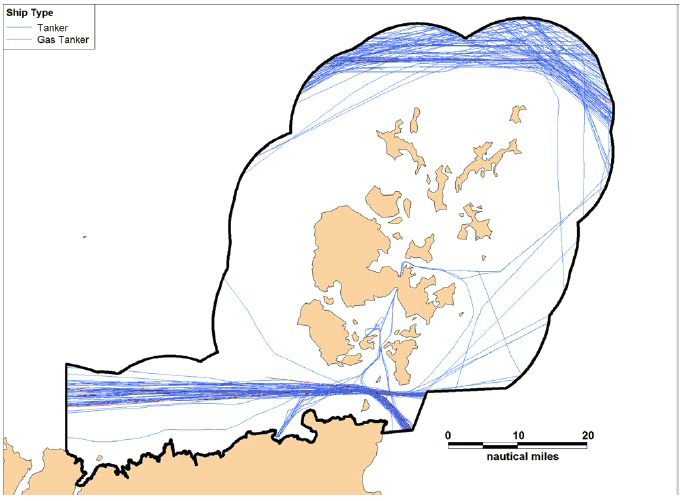
Figure 7.13 Combined 2012 AIS Track Analysis - Tankers & Gas Tankers
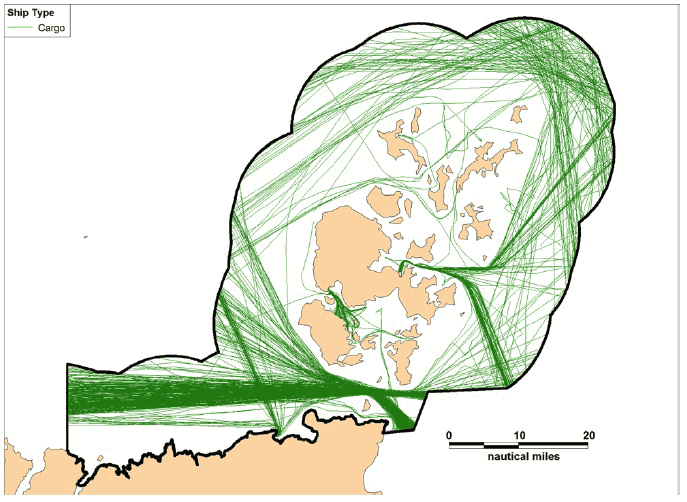
Figure 7.14 Combined 2012 AIS Track Analysis - Cargo Vessels
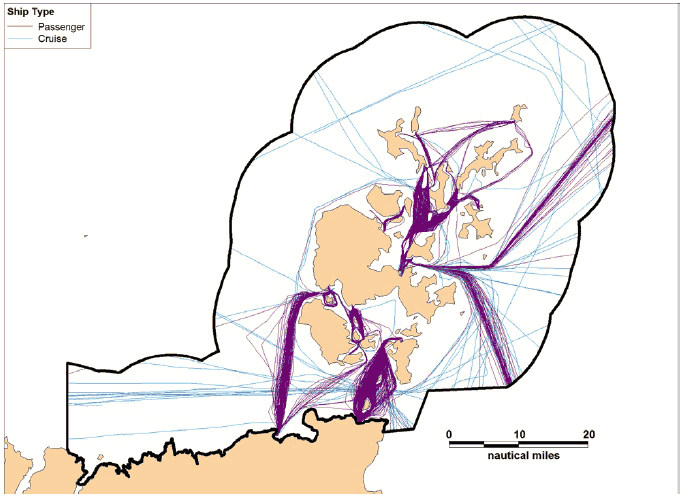
Figure 7.15 Combined 2012 AIS Track Analysis - Passenger and Cruise Vessels
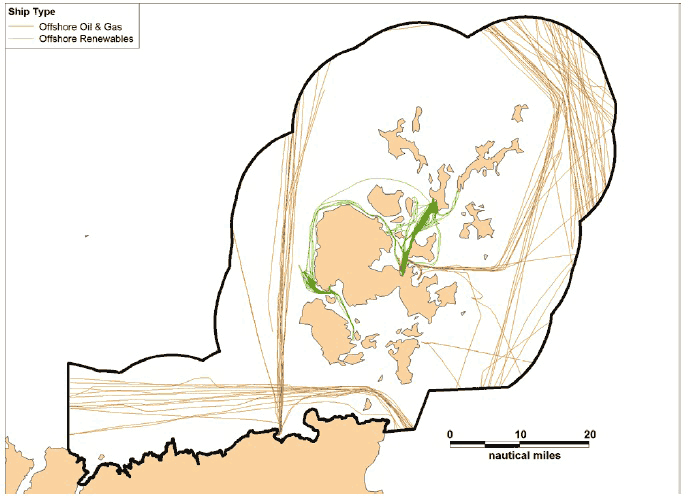
Figure 7.16 Combined 2012 AIS Track Analysis - Offshore Oil & Gas / Renewables Vessels
7.9 Weather and Tidal Routeing Analysis
It was identified in the questionnaire that recreational sailing in the area is strongly influenced by weather and tide. Although this is not as big an influence on commercial shipping, it can still be seen from the AIS analysis that weather and tidal routeing is used, in particular by passenger vessels, to reduce delay and improve passenger comfort during periods of bad weather and/or strong tides.
An example is presented in Figure 7.17 which shows tracks of the Pentland Ferries' Pentalina and Serco NorthLink Ferries' Hamnavoe, crossing the Pentland Firth.
Pentalina, when transiting between Gills Bay and St. Margaret's Hope, most frequently uses the shortest route west of Stroma, which can be seen from the AIS data. Wind and tidal conditions, however, influence the choice of route taken. In easterlies, the ferry will tend to pass west of Stroma, whilst in westerlies the route east of Stroma is preferred. If there is a flood tide and strong southeast winds, then the Master will keep further off Stroma to the west to avoid the risk of drifting towards shore (also, the tide pushes them back on course). If there is an ebb tide and southeast winds then they keep closer to the westerly course of Stroma. In strong westerly winds, the reverse of this would be the case, and they would pass to the east and closer to Stroma in a flood tide and keep further out in an ebb tide.
The Hamnavoe, which serves the Scrabster to Stromness route, usually transits west of Hoy and via Hoy Mouth [40] . However, there is an alternative route via Scapa Flow taken for the comfort of passengers, particularly when heading northbound to Stromness during strong westerlies and ebb tide.
A further example is presented in Figure 7.18 which shows tracks of Orkney Ferries' Earl Thorfinn, between Kirkwall and the outer North Isles, transiting via the Westray Firth. It can be seen the ferry normally navigates close to the islands of Eday or Egilsay to obtain shelter from the weather and tide. When sea conditions and tide are favourable, the vessel takes a more direct route through the Westray Firth.
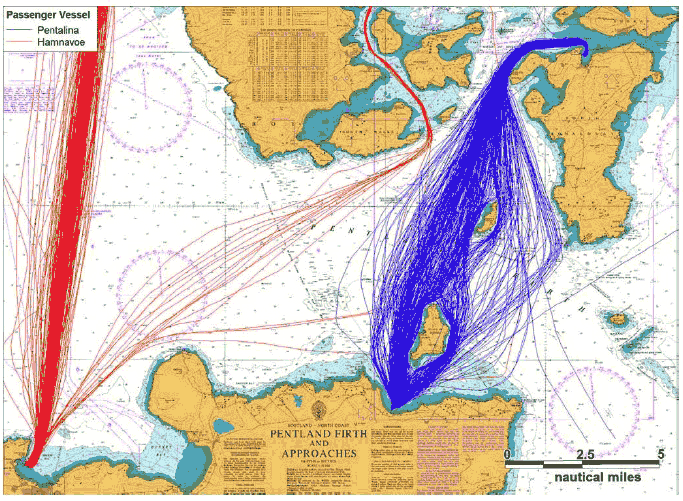
Figure 7.17 Hamnavoe and Pentalina Routeing based on Combined 2012 AIS Track Analysis
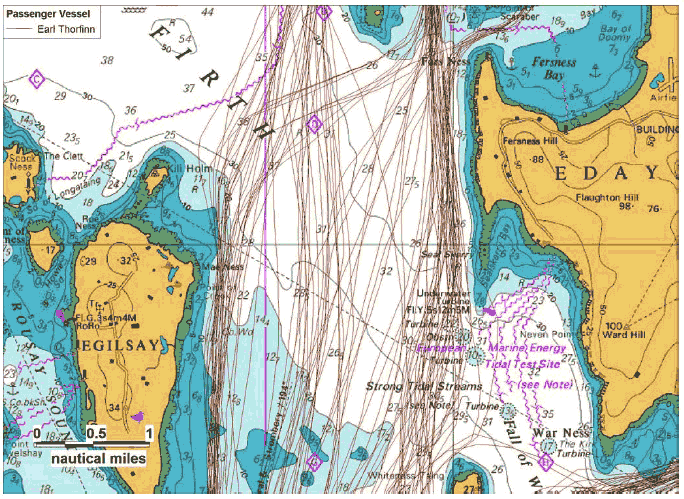
Figure 7.18 Earl Thorfinn Routeing based on Combined 2012 AIS Track Analysis
7.10 Destination Analysis
Excluding 26% of vessels which had an unspecified destination, the most common destinations of vessels within the Strategic Area are presented in Figure 7.19.
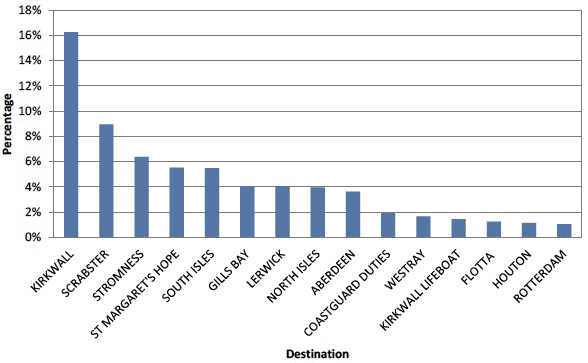
Figure 7.19 AIS 2012 Vessel Destination
Kirkwall was the most recorded destination of vessels within the area (16%), followed by Scrabster (9%) and Stromness (6%). These are all visited by regular ferry services. Many of the other popular destinations are also used by ferries, such as St. Margaret's Hope on South Ronaldsay and Gills Bay (Pentland Ferries). Of the most common destinations, tankers visited Lerwick, Scrabster and Rotterdam. Bulk carriers and cargo vessels were recorded most frequently broadcasting Kirkwall, Scrabster, Aberdeen, Lerwick and Rotterdam as their destinations. From the above list, offshore vessels principally called at Kirkwall, Aberdeen, Stromness and Scrabster.
Lerwick (4%) and Aberdeen (4%) were the most common destinations beyond the PFOW Strategic Area, which is mainly due to the regular ferry service linking Kirkwall with these ports.
It should be noted that AIS destinations listed as 'South Isles' and 'North Isles' were broadcast by Orkney Ferries' vessels. South Isles destinations included Flotta, Houton, Longhope and Lyness. North Isles included Eday, Kirkwall, North Ronaldsay, Papa Westray, Pierowall, Sanday, Stronsay and Westray. In addition to this, the Orkney Ferries vessels Eynhallow, Graemsay and Shapinsay did not broadcast a destination. Eynhallow serves Egilsay, Rousay, Tingwall and Wyre, Graemsay calls at Graemsay, North Hoy and Stromness, and Shapinsay serves Kirkwall and Shapinsay. The above destinations may, therefore, be under-represented in Figure 7.19.
7.11 Anchoring
There was limited ship anchoring within the Strategic Area during the combined survey period. Due to the duration and seasonality of the survey periods, it is likely that this is representative of ship anchoring at all times.
- The floating production tanker, Petrojarl Banff, was at anchor in Scapa Flow during the whole period. Also anchoring within Scapa Flow were two tankers and a tug.
- Two cruise ships used the Cairston Road anchorage area near Stromness, during the summer period.
- On two occasions, the Hebridean Princess passenger cruise vessel used the anchorage area at Tankerness Reef, at the entrance to Deer Sound. Two cargo vessels also anchored here.
- The emergency towing vessels Anglian Sovereign (in winter) and Herakles (in summer) were recorded at anchor in the Bay of Kirkwall and Inganess Bay.
- Bay of Kirkwall was also used by a cruise vessel and a cargo vessel. The cargo vessel also anchored just south of the anchorage area at the Bay of Isbister.
- In the Northern Isles, the Hebridean Princess anchored in a number of locations.
7.12 Ship Hazardous Cargo Analysis
On AIS, certain vessel types (e.g., Passenger, Cargo, Tanker and Other) can indicate whether they are carrying hazardous cargo of the following types:
- Dangerous Goods (DG);
- Harmful Substances (HS); and
- Marine Pollutants (MP).
Four categories are used based on MARPOL Annex II Regulations for the control of pollution by noxious liquid substances in bulk. These are:
- Category X: Noxious Liquid Substances which, if discharged into the sea from tank cleaning or deballasting operations, are deemed to present a major hazard to either marine resources or human health and, therefore, justify the prohibition of the discharge into the marine environment;
- Category Y: Noxious Liquid Substances which, if discharged into the sea from tank cleaning or deballasting operations, are deemed to present a hazard to either marine resources or human health or cause harm to amenities or other legitimate uses of the sea and therefore justify a limitation on the quality and quantity of the discharge into the marine environment;
- Category Z: Noxious Liquid Substances which, if discharged into the sea from tank cleaning or deballasting operations, are deemed to present a minor hazard to either marine resources or human health and therefore justify less stringent restrictions on the quality and quantity of the discharge into the marine environment; and
- Other Substances: substances which have been evaluated and found to fall outside Category X, Y or Z because they are considered to present no harm to marine resources, human health, amenities or other legitimate uses of the sea when discharged into the sea from tank cleaning of deballasting operations. The discharge of bilge or ballast water or other residues or mixtures containing these substances are not subject to any requirements of MARPOL Annex II.
Figure 7.20 and Figure 7.21 present winter and summer plots of vessels that were broadcasting the fact they were carrying hazardous cargoes.
Vessels carrying hazardous cargo tended to be tankers and cargo vessels transiting the Outer Sound and also north of the Strategic Area.
During the winter period, 48% of vessels were tracked carrying the most hazardous category of cargo, Category X, compared with 75% of vessels in summer.
Within the Orkney Islands, several vessels were recorded carrying Category X hazardous cargo. The Havila Fortress cargo vessel was tracked in Scapa Flow carrying Category X hazardous cargo to and from Petrojarl Banff during the winter period. The cargo ship Flinterbirka transited to Kirkwall on 24 January 2012, anchored in Kirkwall Bay, and then made way to Scrabster on 26 January 2012. During the winter period, the Serco NorthLink cargo vessels Helliar and Hildasay were tracked 11 and 25 times, respectively, transiting between Aberdeen / Kirkwall / Lerwick and on all occasions calling at Kirkwall, broadcasting that they were carrying Category X hazardous cargo. During the summer period, Hildasay was recorded 27 times carrying Category X hazardous cargo on the above route. The passenger and cargo ro-ro vessel, Hjaltland, was tracked 3 times in this period broadcasting that it was carrying Category X hazardous cargo, also on the above route. In terms of vessels carrying other categories of hazardous cargo within the Orkney Islands, Hildasay was recorded transiting to Kirkwall then on to Lerwick on 25 January 2012, carrying Other Substances. The product tanker Sarnia Liberty, carrying Category Z hazardous cargo, was tracked en route to Kirkwall then on to Lerwick on 05 July 2012. On 23 July it was bound for Scapa Flow and returned to Immingham the same day. It was also recorded leaving Kirkwall for Stornoway 30 July.
The only additional port within the Strategic Area where vessels were recorded carrying hazardous cargoes (both Category X and Category Y) was Scrabster. During the winter period, the general cargo vessel Flinterbirka was tracked transiting to Scrabster on 26 January 2012, carrying Category X hazardous cargo. The offshore supply cargo vessel Far Service, carrying Category Y hazardous cargo, was recorded transiting to Scrabster on 2 February 2012, before making way to Foinaven Field the same day. In the summer survey, the chemical tanker Lizrix transited to Scrabster on 03 July and made way to Hull the same day. It returned to Scrabster on 12 July 2012 before transiting to Immingham the following day. On 28 July 2012 it returned to Scrabster. On all these occasions it was carrying Category X hazardous cargo.
With the exception of Kirkwall, Scrabster and Petrojarl Banff, no vessels carrying Category X hazardous cargo were tracked visiting any other destinations within the Strategic Area. The only additional destination where a vessel was recorded carrying hazardous cargo (Category Z) within the Strategic Area was Scapa Flow. No vessels carrying hazardous cargo were tracked transiting through the waters close to the west of the Orkney Islands.
The waters around Orkney (excluding the Pentland Firth and Scapa Flow) are categorised by the IMO as an Area to be Avoided (ATBA). To avoid the risk of pollution and damage to the environment, all vessels over 5,000 GT carrying oil or other liquid hazardous cargoes in bulk, should avoid this area. During the survey periods, no tankers were tracked within the ATBA broadcasting on AIS as carrying hazardous cargoes.
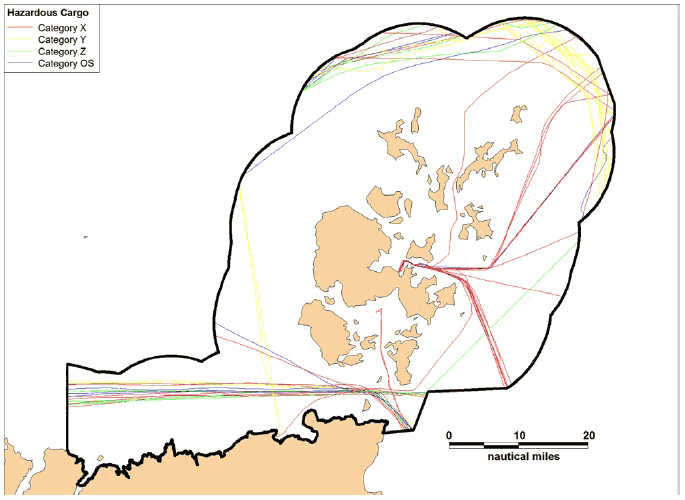
Figure 7.20 Winter 2012 AIS Track Analysis by Hazardous Cargo Category
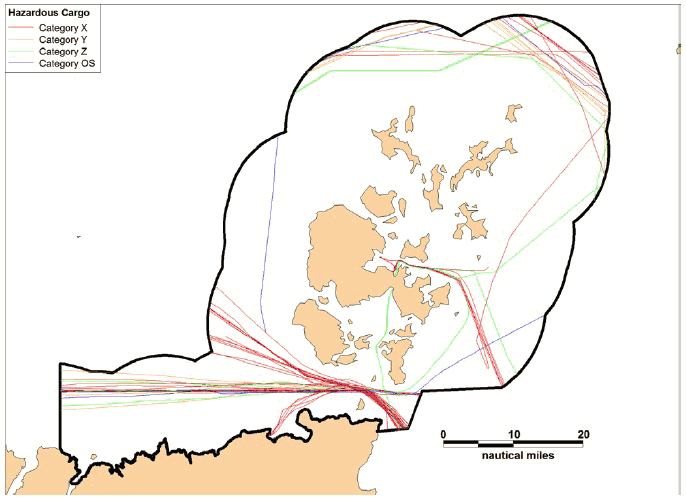
Figure 7.21 Summer 2012 AIS Track Analysis by Hazardous Cargo Category
7.13 Validation of AIS Data using Coastguard Records
The Pentland Firth Reporting System is a voluntary reporting system for laden vessels to report to the Coastguard on VHF Channel 16 at least 1 hour before Estimated Time of Arrival and on final departure of the Pentland Firth.
Coastguard / MCA records represent a subset of the AIS records; therefore studies of commercial vessel movements are likely to be more representative if they are based on AIS data. These records are useful for validation of vessel movements and also for more specific cargo information.
Reports were obtained from the MCA to validate the AIS data of vessels transiting the Pentland Firth, corresponding to the time periods of the AIS surveys.
One day per week was selected (8 days in total) and vessels were matched by name. It was confirmed that the AIS survey included all the vessels logged by the Coastguard. Additionally, it was found that the AIS surveys had logged extra vessels as shown in Figure 7.22.
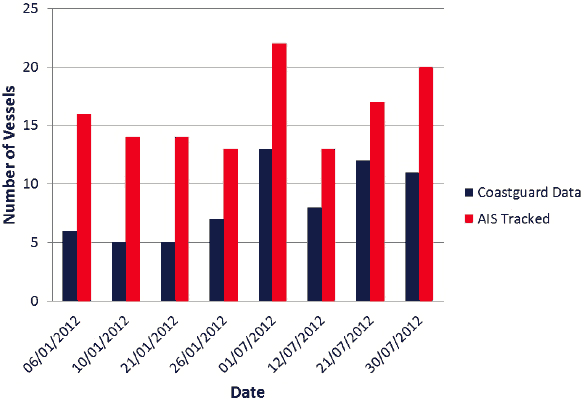
Figure 7.22 Comparison of AIS and Coastguard Vessels for Selected Dates
Most of the additional vessels are not covered by the Pentland Firth Reporting System, such as fishing and leisure vessels.
There were a small proportion of commercial ships which did not report to the Coastguard, presumably because they were not laden or decided not to take part in the voluntary scheme.
The MCA data provided more specific information on vessel cargoes which is not contained within the AIS data. A summary of the cargo information for the vessels transiting the Pentland Firth reporting to the Coastguard comparison of vessel numbers is Figure 7.23.
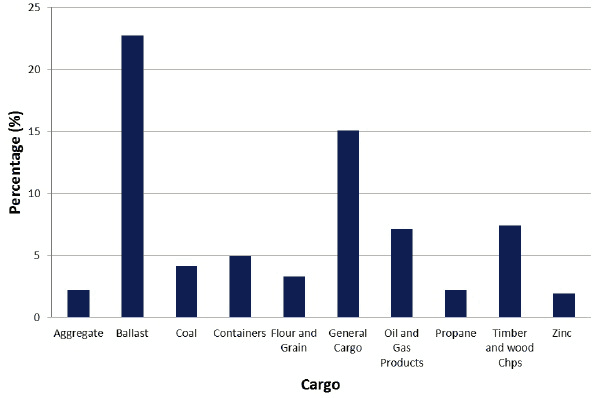
Figure 7.23 Cargoes of Vessels reporting to Coastguard heading via Pentland Firth
It can be seen that the majority of vessels were laden, carrying a mixture of cargoes, but a minority of vessels in ballast reported to the Coastguard (approximately 22%).
7.14 Ship Density Analysis
Figure 7.24 and Figure 7.25 present seasonal plots of the ship density in the PFOW Strategic Area. This is based on a grid of cells 1nm x1nm covering the Strategic Area. The number of AIS tracks crossing each cell has been counted and the grid thematically mapped from lowest density to highest density, where each track corresponds to one vessel movement, based on the relative traffic density levels.
Figure 7.26 presents the change in ship density from winter to summer. The red areas show where there was a significant increase in traffic during summer (at least 20% more tracks) while the blue areas show where winter was busier (20%+). It can be seen that overall, summer was busier than winter which reflects increased passenger vessel movements as well as offshore, other, etc.
Following this, Figure 7.27 to Figure 7.32 present more detailed plots of the seasonal ship density in selected key areas in the PFOW Strategic Area. This is based on a grid of cells of 0.5nm x 0.5nm.
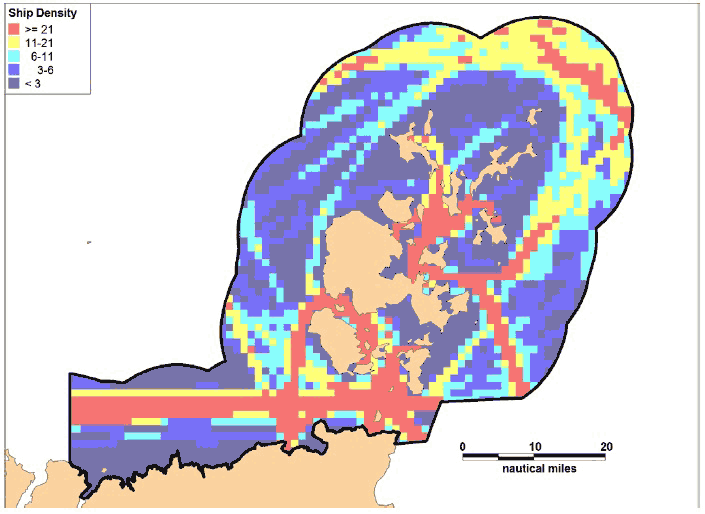
Figure 7.24 Winter 2012 AIS Track Analysis by Overall Ship Density
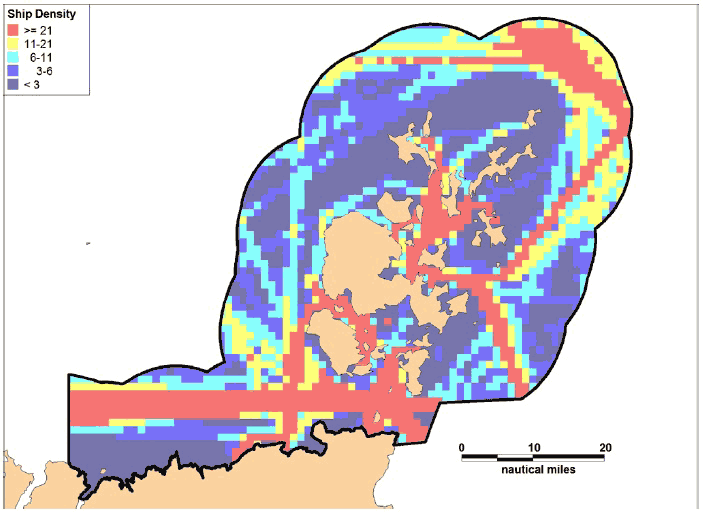
Figure 7.25 Summer 2012 AIS Track Analysis by Overall Ship Density
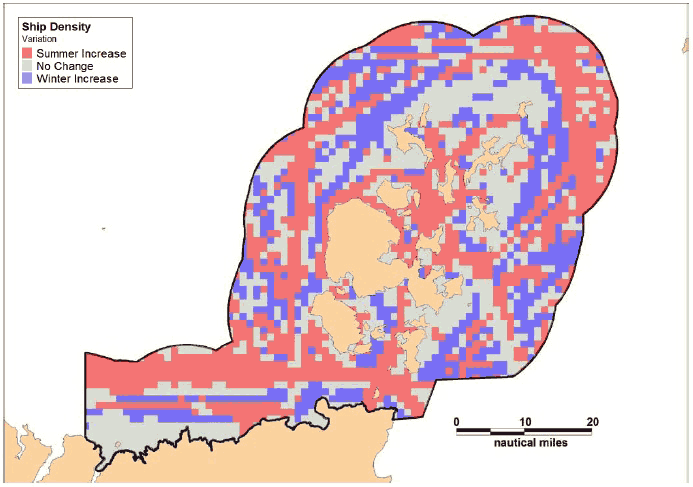
Figure 7.26 2012 AIS Track Analysis by Change in Overall Ship Density
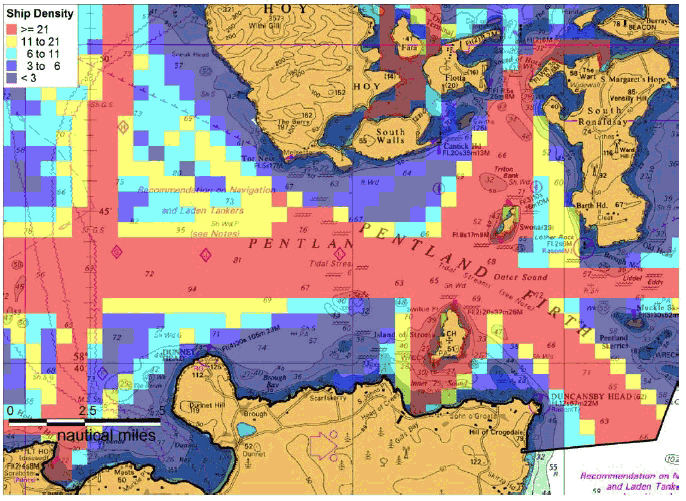
Figure 7.27 Pentland Firth Winter 2012 AIS Track Analysis by Overall Ship Density
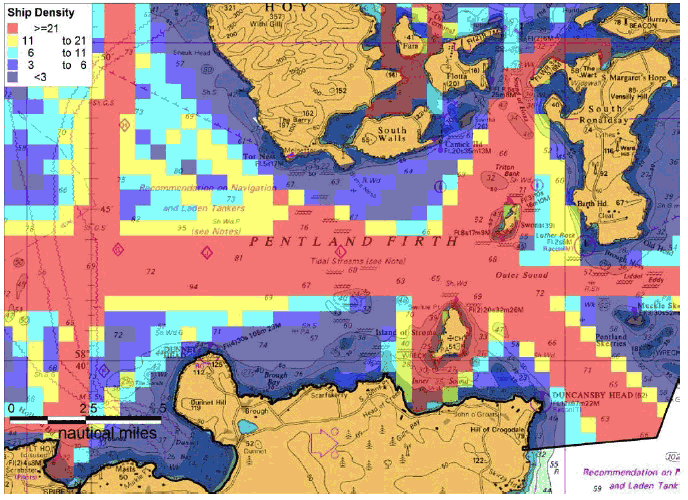
Figure 7.28 Pentland Firth Summer 2012 AIS Track Analysis by Overall Ship Density
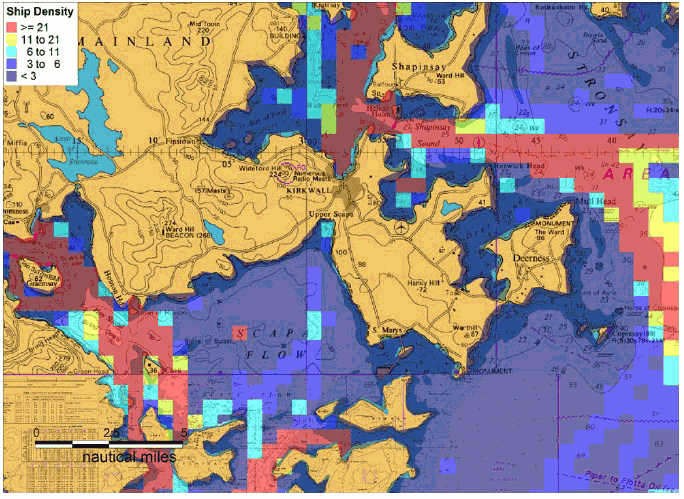
Figure 7.29 Kirkwall Winter 2012 AIS Track Analysis by Overall Ship Density
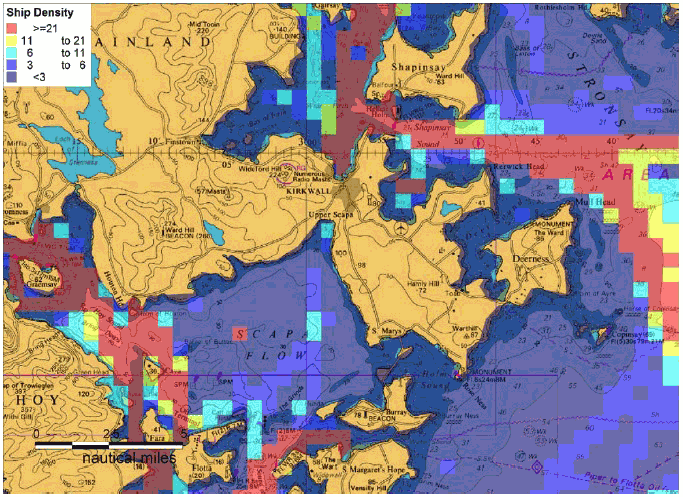
Figure 7.30 Kirkwall Summer 2012 AIS Track Analysis by Overall Ship Density
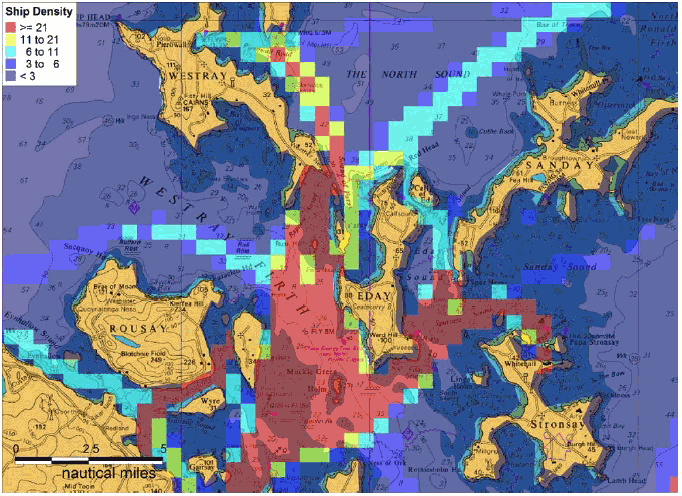
Figure 7.31 Outer Orkney Islands Winter 2012 AIS Track Analysis by Overall Ship Density
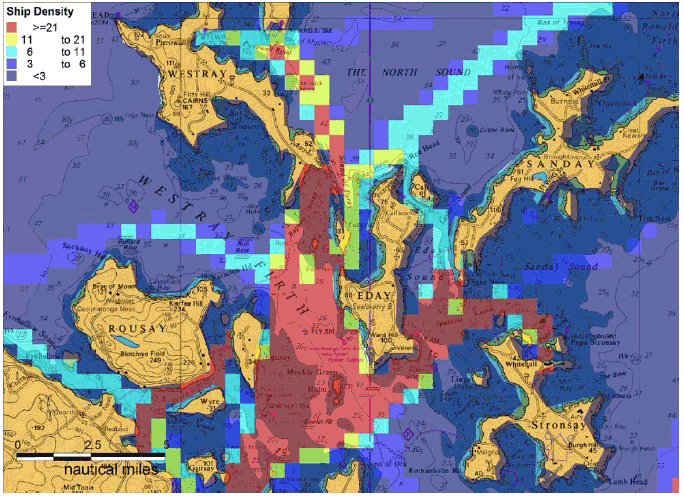
Figure 7.32 Outer Orkney Summer 2012 AIS Track Analysis by Overall Ship Density
Areas of high ship density throughout both summer and winter include routes to and from the main harbours of Kirkwall and Stromness. The east/west transit of the Pentland Firth is also a high density route and could be considered as a key corridor throughout the PFOW Strategic Area. Other key routes and areas of high density include numerous routes throughout the Outer Orkney Islands and routes transiting northwards to Shetland. Areas of relatively low density shipping include west of Mainland Orkney and directly north of the Outer Orkney Islands.
Generally the key routes identified do not change between summer and winter. The trend is for a general increase in shipping density along these key routes in summer compared to winter. This could be due to the increase in passenger and recreational vessels throughout the summer months compared to winter ( Section 7.4). However, subtle variations are present between summer and winter and can be seen in Figure 7.26:
- The northeast/southwest route from Brough Head [41] is only in use throughout the winter months.
- The route bearing north from Hoy Mouth is only in use throughout summer.
- The transit of Eynhallow Sound is only in use throughout summer.
- The northeast / southwest route from Stronsay Firth has a higher level of use throughout summer compared to winter.
- The southeast / northwest transit located at the very north of the PFOW Strategic Area has a higher level of use throughout summer compared to winter.
Contact
There is a problem
Thanks for your feedback